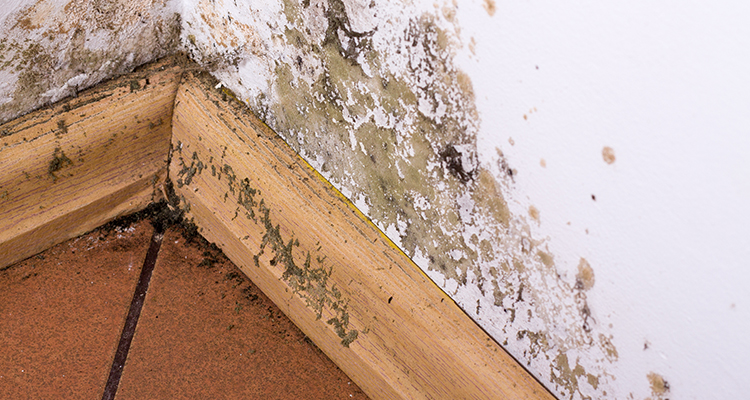Mold, as an organism, has been on this earth for millions of years and occurs naturally virtually everywhere. It’s important to know how to remove mold, as it can pose serious health issues.
In this blog, we’ll cover what causes isolated mold growth, how to properly remove mold once discovered, share tips for cleaning it on your own and suggest when it’s recommended to call a pro. Be educated and read more about how to remove mold.
How Did Mold Get Here in the First Place?
As mold removal experts, we know a lot about mold – how and where it grows and how to get rid of it. Spoiler – it’s not bleach. The truth is mold exists in nature and is inside your home right now.
Similar to humidity, there is such a thing as official “safe” or “normal” levels. When a home or commercial building has too much humidity or suffers water damage, however, it’s at risk for excess mold formation. Common situations include:
- Heavy rains
- Natural disasters
- Broken ice maker line
- Washer hose break
- Water heater leak
- Toilet overflow
- Tub overflow
- Supply line break
- Leaky pipe or garbage disposal discharge
Basically, anytime there’s water in a place where it doesn’t belong and it has the right conditions, mold grows. Mold prefers the dark, like a cabinet under a leaky sink. The back of a closet with excess humidity and low airflow provides the perfect conditions for mold to flourish.
If you’ve experienced water damage with standing water in a crawlspace or basement, the amount of water saturation and length of time the water is there leaves a higher risk of mold growth. Let’s review some other common questions…
Why Do I Need to Know How to Remove Mold Quickly?
It’s critical to tackle water damage quickly to reduce the chance of mold. The longer the water sits, the longer it has to permeate porous surfaces.
Therefore, the longer it sits, the worse the risk. Porous surfaces are anything water could penetrate. Damp or wet wood, drywall, flooring and furnishings provide a perfect medium for mold growth.
How to Remove Mold with a Dry Out
A dry out is what it sounds like. Expert mold remediation specialists use sophisticated equipment to dry the space. These include moisture meters, air movers and heavy-duty dehumidifiers.
In many instances, air-scrubbers are utilized that capture mold spores during a dry out or demo of an affected area to protect occupants and to curb the spread of mold spores.
Penetrating and non-penetrating meters are used throughout the process. An affected area that may feel dry to the touch, may have a moisture content far above the dry standard throughout the rest of the structure.
While every job is unique due to the many variables present – time, amount of moisture, length of exposure, etc., the dry out process can typically be accomplished in 3-5 days.
The dry out starts immediately once equipment has been set on the job. Our technicians will monitor progress and will adjust equipment to most efficiently dry the space in the shortest amount of time possible.
Will Mold Make Me Sick?
Different people react differently to exposure to mold spores. Some people are sensitive and may experience cold symptoms or a rash.
For those with compromised immune systems, the elderly, pregnant women and children even short-term exposure can cause serious health complications. Long-term exposure may contribute to respiratory illnesses, such as asthma, especially for children.
How to Remove Mold On My Own
A homeowner can typically remediate an affected area of 10 square feet or less on their own. The following steps provide a general outline of procedures to safely remediate a small area of mold:
Step One: Put on a pair of disposable gloves and cover the mold with plastic. Even a trash bag will work okay. Tape the plastic to the wall.
Step Two: Cut out the drywall in the affected area and quickly place it in a trash bag. Remove it from the area unless…
Step Three: If there is mold inside the wall cavity or on the backside of the drywall, place the drywall back into the hole. Tape up the seams and leave it for evaluation by a professional. If there is mold inside the walls or the overall surface area is greater than you realized, we recommend calling professionals.
Don’t risk your health trying to do it alone. We know how to remove mold safely and discreetly.
If you have a slight haze of what appears to be mold growth on surfaces, use a mild dishwashing detergent with water and wash it off. Nothing else is needed. Most people think bleach will work, when in reality it does not.
When You Need to Know How to Remove Mold – Call Mold Remediation Pros – AMERESTORE
In conclusion, call a tested restoration company like AMERESTORE. We’ve served people in their time of need for more than 30 years. We take care of homeowners and business and property owners with safe, efficient and discreet service. We’ll be there for you with a quick response.
We take our work seriously and give every job 100 percent, whether at home or responding to a disaster many states away. When you have a need due to water damage, fire and smoke damage, storm or hurricane damage or mold remediation, call AMERESTORE.

